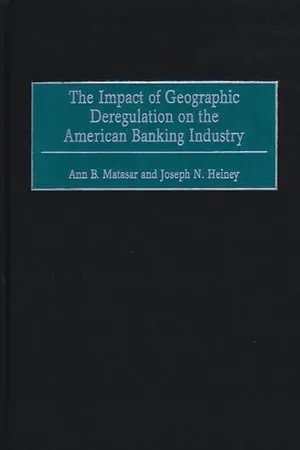
The Impact of Geographic Deregulation on the American Banking Industry
- 216 pages
- English
- PDF
- Available on iOS & Android
The Impact of Geographic Deregulation on the American Banking Industry
About This Book
With the passage of the Riegle-Neal Interstate Banking and Branching Efficiency Act and the Riegle Community Development and Regulatory Improvement Act in 1994, some Americans celebrated the dawn of a new banking era. These laws, which provided some relief from regulation, represented the first revision of the Glass-Steagall Act of 1933. In the intervening sixty years, the U.S. banking industry had undergone dramatic changes, both domestically and internationally, and yet the laws associated with banking remained fixed and intransigent. No amount of regulatory flexibility or bankers' ingenuity was able to substitute fully for modernization of the banking laws necessary to keep pace with the revolution in the banking and financial services industries. The new legislation represented a rapid realignment of American banking laws with societal norms; as such, it generated confusion and uncertainty for many bankers and their constituents, for example, stockholders, customers, and employees. Matasar and Heiney examine public data since 1994 in an effort to fully apprise scholars and practitioners of the changes that have irrevocably altered the landscape of American banking. The Riegle-Neal Act and the Riegle Act were the first blows to the dominance of Depression-era legislation in banking. The second was the Gramm-Leach-Bliley Financial Services Modernization Act of 1999, which eliminated major portions of the Glass-Steagall Act. This study, which analyzes data from 1994 to 1999, ably captures and isolates the effects on American banking of the twin Riegle laws alone, with the noted exceptions of changed circumstances that may have resulted from other environmental factors (but not from other banking legislation). The focus here is on interstate banking experiences. Matasar and Heiney's analysis reveals the direction that changes associated with the law are likely to take and thus serves as a baseline for future research and analysis.
Frequently asked questions
Table of contents
- Contents
- Preface
- Chapter 1 Introduction
- Chapter 2 The Economic and Financial Health of America's Banks: The Effects of Consolidation on the Private Sector
- Chapter 3 The Public Effects of Interstate Banking Expansion: The Impact on Bank Customers
- Chapter 4 The Public Effects of Interstate Banking Expansion: The Impact on Employees
- Chapter 5 A Microanalysis: Case Studies
- Chapter 6 Summary
- Appendix 1: Banks by Asset Size, 1990–1998
- Appendix 2: Aggregate Condition and Income Data
- Appendix 3: Performance Ratios
- Appendix 4: Condition Ratios
- Appendix 5: McFadden-Pepper Act of 1927
- Appendix 6: Riegle-Neal Interstate Banking and Branching Efficiency Act of 1994
- Bibliography
- Index